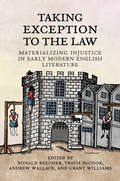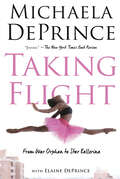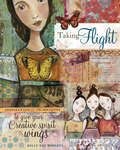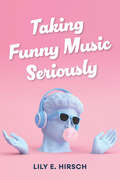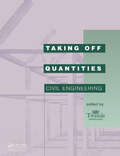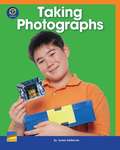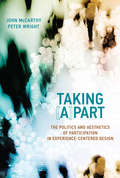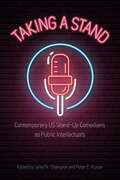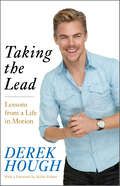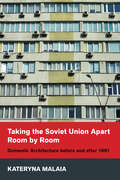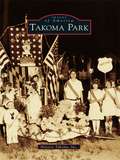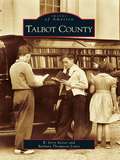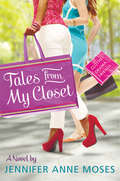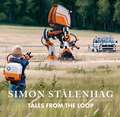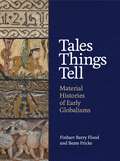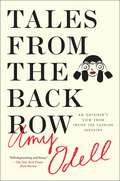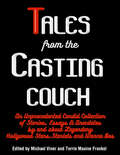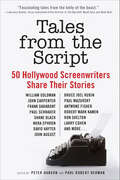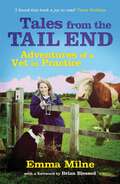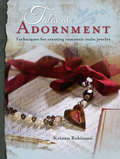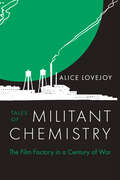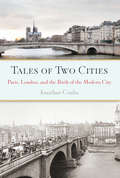- Table View
- List View
Taking Exception to the Law: Materializing Injustice in Early Modern English Literature
by Edited by Donald Beecher Travis Decook Andrew Wallace Grant WilliamsTaking Exception to the Law explores how a range of early modern English writings responded to injustices perpetrated by legal procedures, discourses, and institutions. From canonical poems and plays to crime pamphlets and educational treatises, the essays engage with the relevance and wide appeal of legal questions in order to understand how literature operated in the early modern period. Justice in its many forms – legal, poetic, divine, natural, and customary – is examined through insightful and innovative analyses of a number of texts, including The Merchant of Venice, The Faerie Queene, and Paradise Lost. A major contribution to the growing field of law and literature, this collection offers cultural contexts, interpretive insights, and formal implications for the entire field of English Renaissance culture.
Taking Flight: From War Orphan to Star Ballerina
by Michaela Deprince Elaine DeprinceMichaela DePrince was known as girl Number 27 at the orphanage, where she was abandoned at a young age and tormented as a "devil child" for a skin condition that makes her skin appear spotted. But it was at the orphanage that Michaela would find a picture of a beautiful ballerina en pointe that would help change the course of her life. At the age of four, Michaela was adopted by an American family, who encouraged her love of dancing and enrolled her in classes. She went on to study at the Jacqueline Kennedy Onassis School at the American Ballet Theatre and is now the youngest principal dancer with the Dance Theatre of Harlem. She has appeared in the ballet documentary First Position, as well as on Dancing with the Stars, Good Morning America, and Nightline. In this engaging, moving, and unforgettable memoir, Michaela shares her dramatic journey from an orphan in West Africa to becoming one of ballet's most exciting rising stars.
Taking Flight: Inspiration And Techniques To Give Your Creative Spirit Wings
by Kelly Rae RobertsStretch Your Wings, Learn to Soar, Take FlightIn Taking Flight, you'll find overflowing inspiration–complete with a kindred spirit in author and mixed-media artist Kelly Rae Roberts. Join her on a fearless journey into the heart of creativity as you test your wings and learn to find the sacred in the ordinary, honor your memories, speak your truth and wrap yourself in the arms of community.Along the way you'll be inspired by:Step-by-step techniques–learn the most-loved mixed-media methods of the author and seven talented contributing artists, and combine them in fresh and unexpected ways.Thought-provoking prompts and quotes–along with encouraging stories, insights and gentle guidance for finding your bliss, whatever your art or craft.Plenty of eye-candy–pages and pages of the author's endearing artwork, along with the varied works of the contributors.Of course, learning to fly isn't entirely a step-by-step process–sooner or later, you just need to take a deep breath and spread your wings. With Taking Flight as your guide, there's no doubt that when you do, your creativity will soar.
Taking Funny Music Seriously (Comedy & Culture)
by Lily E. HirschTake funny music seriously! Though often dismissed as silly or derivative, funny music, Lily E. Hirsch argues, is incredibly creative and dynamic, serving multiple aims from the celebratory to the rebellious, the entertaining to the mentally uplifting. Music can be a rich site for humor, with so many opportunities that are ripe for a comedic left turn. Taking Funny Music Seriously includes original interviews with some of the best musical humorists, such as Tom Lehrer, "the J. D. Salinger of musical satire"; Peter Schickele, who performed as the invented composer P. D. Q. Bach, the supposed lost son of the great J. S. Bach; Kate Micucci and Riki Lindhome of the funny music duo Garfunkel and Oates; comedic film composer Theodore Shapiro; Too Slim of the country group Riders in the Sky; and musical comedian Jessica McKenna, from the podcast Off Book, part of a long line of "funny girls." With their help, Taking Funny Music Seriously examines comedy from a variety of genres and musical contexts—from bad singing to rap, classical music to country, Broadway music to film music, and even love songs and songs about death.In its coverage of comedic musical media, Taking Funny Music Seriously is an accessible and lively look at funny music. It offers us a chance to appreciate more fully the joke in music and the benefits of getting that joke—especially in times of crisis—including comfort, catharsis, and connection.
Taking Off Quantities: Civil Engineering (Spon's Price Books)
by Bryan SpainThis book provides a thorough understanding of the general principles of measurement for taking off quantities. An essential guide to any quantity surveyor, architect or engineer. Taking off quantities: Civil Engineering demonstrates, through a series of detailed worked examples from a range of civil engineering projects, how the measurement techni
Taking Photographs
by Lynne AndersonLearn how to make a pinhole camera. (Set of 6 with Common Core Editions of Teacher Materials)
Taking [A]part: The Politics and Aesthetics of Participation in Experience-Centered Design (Design Thinking, Design Theory)
by Peter Wright John McCarthyA critical inquiry into the value and experience of participation in design research.In Taking [A]part, John McCarthy and Peter Wright consider a series of boundary-pushing research projects in human-computer interaction (HCI) in which the design of digital technology is used to inquire into participative experience. McCarthy and Wright view all of these projects—which range from the public and performative to the private and interpersonal—through the critical lens of participation. Taking participation, in all its variety, as the generative and critical concept allows them to examine the projects as a part of a coherent, responsive movement, allied with other emerging movements in DIY culture and participatory art. Their investigation leads them to rethink such traditional HCI categories as designer and user, maker and developer, researcher and participant, characterizing these relationships instead as mutually responsive and dialogical.McCarthy and Wright explore four genres of participation—understanding the other, building relationships, belonging in community, and participating in publics—and they examine participatory projects that exemplify each genre. These include the Humanaquarium, a participatory musical performance; the Personhood project, in which a researcher and a couple explored the experience of living with dementia; the Prayer Companion project, which developed a technology to inform the prayer life of cloistered nuns; and the development of social media to support participatory publics in settings that range from reality game show fans to on-line deliberative democracies.
Taking a Stand: Contemporary US Stand-Up Comedians as Public Intellectuals
by Jared N. Champion and Peter C. KunzeContributions by Jared N. Champion, Miriam M. Chirico, Thomas Clark, David R. Dewberry, Christopher J. Gilbert, David Gillota, Kathryn Kein, Rob King, Rebecca Krefting, Peter C. Kunze, Linda Mizejewski, Aviva Orenstein, Raúl Pérez, Philip Scepanski, Susan Seizer, Monique Taylor, Ila Tyagi, and Timothy J. Viator Stand-up comedians have a long history of walking a careful line between serious and playful engagement with social issues: Lenny Bruce questioned the symbolic valence of racial slurs, Dick Gregory took time away from the stage to speak alongside Martin Luther King Jr., and—more recently—Tig Notaro challenged popular notions of damaged or abject bodies. Stand-up comedians deploy humor to open up difficult topics for broader examination, which only underscores the social and cultural importance of their work. Taking a Stand: Contemporary US Stand-Up Comedians as Public Intellectuals draws together essays that contribute to the analysis of the stand-up comedian as public intellectual since the 1980s. The chapters explore stand-up comedians as contributors to and shapers of public discourse via their live performances, podcasts, social media presence, and political activism. Each chapter highlights a stand-up comedian and their ongoing discussion of a cultural issue or expression of a political ideology/standpoint: Lisa Lampanelli’s use of problematic postracial humor, Aziz Ansari’s merging of sociology and technology, or Maria Bamford’s emphasis on mental health, to name just a few. Taking a Stand offers a starting point for understanding the work stand-up comedians do as well as its reach beyond the stage. Comedians influence discourse, perspectives, even public policy on myriad issues, and this book sets out to take those jokes seriously.
Taking the Lead: Lessons from a Life in Motion
by Derek HoughThe Emmy Award winner and only five-time champion of the hit ABC reality show Dancing with the Stars tells the inspiring story of his life and career.For eleven seasons, millions of people have tuned in to Dancing with the Stars to watch Derek Hough, the talented, consummate competitor whose skill and commitment have made him the show’s all-time champion. Whether he’s dancing with an Olympic gold medalist, an internationally renowned recording star, or a celebrated actress, Derek instills in each of his celebrity partners a deep passion, respect for hard work, and an irrepressible joie de vie spirit.Now, for the first time ever, Derek opens up about his life and the lessons he’s learned on and off the dance floor, revealing how he went from bullied boy to ballroom boss. He details how his experiences have taught him to embrace a positive outlook, and shares the insights he’s gained working with celebrity partners, along with never-before-told, behind-the-scenes stories from the show.Throughout, Derek spills the real secrets of learning to dance—connection, respect, and cooperative commitment—and demonstrates how he draws on the lessons of dance and competition to embrace and overcome the daily challenges we all face.
Taking the Soviet Union Apart Room by Room: Domestic Architecture before and after 1991 (NIU Series in Slavic, East European, and Eurasian Studies)
by Kateryna MalaiaTaking the Soviet Union Apart Room by Room investigates what happens to domestic spaces, architecture, and the lives of urbanites during a socioeconomic upheaval. Kateryna Malaia analyzes how Soviet and post-Soviet city dwellers, navigating a crisis of inadequate housing and extreme social disruption between the late 1980s and 2000s, transformed their dwellings as their countries transformed around them. Soviet infrastructure remained but, in their domestic spaces, urbanites transitioned to post-Soviet citizens. The two decades after the collapse of the USSR witnessed a major urban apartment remodeling boom. Malaia shows how, in the context of limited residential mobility, those remodeling and modifying their homes formed new lifestyles defined by increased spatial privacy. Remodeled interiors served as a material expression of a social identity above the poverty line, in place of the outdated Soviet signifiers of well-being. Connecting home improvement, self-reinvention, the end of state socialism, and the lived experience of change, Malaia puts together a comprehensive portrait of the era. Malaia shows both the stubborn continuities and the dramatic changes that accompanied the collapse of the USSR. Making the case for similarities throughout the former Soviet empire, this study is based on interviews and fieldwork done primarily in Kyiv and Lviv, Ukraine. Many of the buildings described are similar to those damaged or destroyed by Russian bombings or artillery fire following the invasion of Ukraine on February 24, 2022. A book about major historic events written through the lens of everyday life, Taking Soviet Union Apart is also about the meaning of home in a dramatically changing world.
Taking the Soviet Union Apart Room by Room: Domestic Architecture before and after 1991 (NIU Series in Slavic, East European, and Eurasian Studies)
by Kateryna MalaiaTaking the Soviet Union Apart Room by Room investigates what happens to domestic spaces, architecture, and the lives of urbanites during a socioeconomic upheaval. Kateryna Malaia analyzes how Soviet and post-Soviet city dwellers, navigating a crisis of inadequate housing and extreme social disruption between the late 1980s and 2000s, transformed their dwellings as their countries transformed around them. Soviet infrastructure remained but, in their domestic spaces, urbanites transitioned to post-Soviet citizens. The two decades after the collapse of the USSR witnessed a major urban apartment remodeling boom. Malaia shows how, in the context of limited residential mobility, those remodeling and modifying their homes formed new lifestyles defined by increased spatial privacy. Remodeled interiors served as a material expression of a social identity above the poverty line, in place of the outdated Soviet signifiers of well-being. Connecting home improvement, self-reinvention, the end of state socialism, and the lived experience of change, Malaia puts together a comprehensive portrait of the era. Malaia shows both the stubborn continuities and the dramatic changes that accompanied the collapse of the USSR. Making the case for similarities throughout the former Soviet empire, this study is based on interviews and fieldwork done primarily in Kyiv and Lviv, Ukraine. Many of the buildings described are similar to those damaged or destroyed by Russian bombings or artillery fire following the invasion of Ukraine on February 24, 2022. A book about major historic events written through the lens of everyday life, Taking Soviet Union Apart is also about the meaning of home in a dramatically changing world.
Takoma Park
by Inc. Historic TakomaThe story of Takoma Park begins in 1883 when B. F. Gilbert purchased 90 acres of hilly woodlands straddling the District of Columbia-Maryland border and laid out Washington's first railroad suburb, ideally situated for the families of federal workers. Envisioning a healthful and forward-looking community, Gilbert also arranged for leaders of the health-minded Seventh-day Adventist Church to move to Takoma Park. By the early 20th century, the town was well established, and residents were creating traditions to pass on to those who followed, including an Independence Day celebration that is one of the oldest in the state. Community activism has been a hallmark of Takoma Park since a 1965 plan to build a freeway through the heart of the town. This sparked a citizen-led protest that stopped construction and led to the creation of historic districts on both sides of the D.C.-Maryland boundary line. The city's reputation as a feisty and culturally diverse community continues to be a source of pride, attracting artists, activists, and new residents from countries around the world.
Talbot County
by R. Jerry Keiser Barbara Thompson LewisSituated on the Eastern Shore of Maryland on the Chesapeake Bay, Talbot County, with its many rivers, creeks, inlets, and islands, boasts 600 miles of scenic shoreline. The birthplace of Frederick Douglass, Talbot County has a rich history of waterfront towns and villages and a serene beauty and tradition, which made the county the ideal setting for Pulitzer Prize-winning author James Michener's novel Chesapeake. Easton, the county seat, is home to the Third Haven Meeting House, which was built in 1661 and is the oldest wooden church still in use in America. In Images of America: Talbot County, historical documents, vintage postcards, photographs of local families, and other memorabilia depict the county's people, places, and pastimes. This volume features prominent Talbot County figures as well as many images of Easton, St. Michaels, Oxford, Trappe, Tilghman Island, and other remarkable locations.
Tales From My Closet
by Jennifer Anne MosesFive girls. A paper dress. Tons of shoes. One unforgettable raincoat. White Jeans. Secrets. Drama. Friends?For Justine, Bianca, Becka, Polly, and Anne, living in Westfield, New Jersey is "life on planet toilet paper." At least that's how Justine feels when she shows up as the new girl in school wearing a Scott Paper Caper dress. To her, it's a super-original fashion statement. But other "loser freaks" don't agree. The other girls have their own fashion issues, ranging from fabulous boots to raggedy pajamas to what to wear to therapy. Told in alternating voices, TALES FROM MY CLOSET follows the stories of high school kids who have nothing in common--and everything in common. They're at war with each other, but through their clothes, they reveal and conceal themselves and make peace with what it means to be a teen. Over the course of a school year, their individual struggles and successes come together to tell a story that's funny, honest, and all-girl fabulous.
Tales From the Loop
by Simon StålenhagThe basis for the new Amazon Prime Original Series! Perfect for fans of E.T. and Stranger Things—the first narrative artbook from acclaimed author and artist Simon Stålenhag about a fictionalized suburban town in the 1980s inhabited by fantastic machines and strange, imaginative beasts.In 1954, the Swedish government ordered the construction of the world&’s largest particle accelerator. The facility was complete in 1969, located deep below the pastoral countryside of Mälaröarna. The local population called this marvel of technology The Loop. These are its strange tales. From the same author who wrote the imaginative artbook The Electric State, this &“haunting,&” (The Verge) &“sophisticated sci-fi&” (The Nerdist) follows the bizarre stories from otherworldly creatures and is a page-turner you won&’t be able to put down.
Tales Things Tell: Material Histories of Early Globalisms
by Finbarr Barry Flood Beate FrickeNew perspectives on early globalisms from objects and imagesTales Things Tell offers new perspectives on histories of connectivity between Africa, Asia, and Europe in the period before the Mongol conquests of the thirteenth century. Reflected in objects and materials whose circulation and reception defined aesthetic, economic, and technological networks that existed outside established political and sectarian boundaries, many of these histories are not documented in the written sources on which historians usually rely. Tales Things Tell charts bold new directions in art history, making a compelling case for the archival value of mobile artifacts and images in reconstructing the past.In this beautifully illustrated book, Finbarr Barry Flood and Beate Fricke present six illuminating case studies from the sixth to the thirteenth centuries to show how portable objects mediated the mobility of concepts, iconographies, and techniques. The case studies range from metalwork to stone reliefs, manuscript paintings, and objects using natural materials such as coconut and rock crystal. Whether as booty, commodities, gifts, or souvenirs, many of the objects discussed in Tales Things Tell functioned as sources of aesthetic, iconographic, or technical knowledge in the lands in which they came to rest. Remapping the histories of exchange between medieval Islam and Christendom, from Europe to the Indian Ocean, Tales Things Tell ventures beyond standard narratives drawn from written archival records to demonstrate the value of objects and images as documents of early globalisms.
Tales from the Back Row: An Outsider's View from Inside the Fashion Industry
by Amy OdellA keenly observed collection of personal essays about what it’s like to be a young woman working in the fashion industry, Amy Odell’s Tales from the Back Row offers “a backstage pass to the intimidating, backbiting industry” (US Weekly).In the “funny, insightful” (Harper’s Bazaar) Tales from the Back Row, Cosmopolitan.com editor Amy Odell takes readers behind the stage of New York’s hottest fashion shows to meet the world’s most influential models, designers, celebrities, editors, and photographers. But first, she has to push her way through the crowds outside and weave her way through the packed venue, from the very back row to the front. And as Amy climbs the ladder (with tips about how you can, too), she introduces an industry powered by larger-than-life characters: she meets the intimidating Anna Wintour and the surprisingly gracious Rachel Zoe, not to mention the hilarious Chelsea Handler, and more. As she describes the allure of Alexander Wang’s ripped tights and Marchesa’s Oscar-worthy dresses, Amy layers in something else: how the fashion industry is an exaggerated mirror of human fallibility—reflecting our desperate desire to belong, to make a mark. In her “light-hearted, cocktail-hour confession from someone who is…sober enough to recognize insanity for what it is” (The Washington Post), Amy is the first to admit that as much as she is embarrassed by the thrill she gets when she receives an invitation to an exclusive after-party, she can’t help but RSVP “yes.” Welcome to the weird and wonderful world of high fashion: “Whether you’re interested in pursuing a career in publishing, public relations, or design, or you’re just fascinated with what really goes on behind-the-scenes without the usual sugarcoating, we’d say this is required reading” (Fashionista.com).
Tales from the Big House: 400 Years of Its History and People
by Stephen WadeTales from the Big House: Normanby Hall tells the story of a place known perhaps today mainly as the home where Samantha Cameron grew up, but historically it has been the seat of the Sheffield family, whose most famous member was arguably the Duke of Buckingham in the seventeenth century. As with most country houses, the Hall was used as a military hospital in the Great War, and in the Second World War there were military personnel based there again. It stands just a few miles from the great steelworks on the Brigg Road, which have always defined Scunthorpe, so it played its part in the history of steel-making also.The book includes biographies of the famous but also tells of the lives of the ordinary people who kept the house and the estate going, from the gamekeepers to the gardeners, and the cooks to the stable hands. All this is set against the social background through the centuries of its existence, up to the sale of the Hall to Scunthorpe Borough Council in 1964. The lives familiar to us today from Downton Abbey and similar family sagas are at the heart of Stephen Wades history. But along the way, the reader will meet such characters as Sir Berkeley Sheffield, model railway enthusiast, Walter Brierley, architect, Thomas Sumpter, the schoolmaster, John Fletcher, machine-maker, and perhaps most charismatically of all, Lady Arthur Grosvenor, an expert on gypsy caravans.
Tales from the Casting Couch: An Unprecedented Candid Collection of Stories, Essays, and Anecdotes by and about Legendary Hollywood Stars, Starlets, and Wanna-Bes
by Michael Viner Terrie Maxine FrankelIn Hollywood, securing a coveted role in a big-budget film or landing a part in a prestigious feature sometimes doesn' t come down to who or what you know— but how far you' re willing to go. Tales from the Casting Couch is an anthology of little-known stories and anecdotes about actual casting sessions that propelled then-unknown actors to fame or established stars who secured themselves second acts. Learn how Dustin Hoffman mumbled his way out of the wrong job, why Orson Welles got a second chance from Lucy and Desi, and much more. This collection of stories features many Hollywood' s stars and legends, such as Sally Field, Whoopi Goldberg, Steve Martin, Robert Redford, Sylvester Stallone, John Travolta, and many, many others. In chapters like “ Chutzpah,” “ Size Is Everything,” “ Date with Destiny,” and “ Sex, Sex, Sex,” everyone from actors and actresses to producers and casting directors share some of the most outrageous stories about life behind the scenes in Tinseltown.
Tales from the Script: 50 Hollywood Screenwriters Share Their Stories
by Peter Hanson and Paul Robert HermanDiscover the secrets of Hollywood storytelling in this fascinating collection, in which fifty screenwriters share the inside scoop about how they surmounted incredible odds to break into the business, how they transformed their ideas into box-office blockbusters, how their words helped launch the careers of major stars, and how they earned accolades and Academy Awards. Entertaining, informative, and sometimes startling, Tales from the Script features exclusive interviews with film's top wordsmiths, including John Carpenter (Halloween), Nora Ephron (Julie & Julia), John August (Charlie and the Chocolate Factory), and David hayter (Watchmen). Read along as:Frank Darabont explains why he sacrificed his salary to preserve the integrity of his hard-hitting adapta-tion of Stephen King's novella The Mist.William Goldman reveals why he's never had any interest in directing movies, despite having won Oscars for writing All the President's Men and Butch Cassidy and the Sundance Kid.Ron Shelton explains why he nearly cut the spectacular speech that helped cement Kevin Costner's stardom in Bull Durham.Josh Friedman describes the bizarre experience of getting hired by Steven Spielberg to adapt H. G. Wells's classic novel War of the Worlds—even though Spielberg hated Friedman's take on the material.Paul Schrader (Taxi Driver) analyzes his legendary relationship with Martin Scorsese.Shane Black (Lethal Weapon) reveals why the unrelenting hype around his multimillion-dollar script sales caused him to retreat from public life for several years.Tales from the Script is a must for movie buffs who savor behind-the-scenes stories—and a master class for all those who dream of writing the Great American Screenplay, taught by those who made that dream come true.
Tales from the Tail End: Adventures of a Vet in Practice
by Emma MilneIn 1996, Emma Milne started her first job as a newly qualified vet, a career captured on camera for television’s Vets in Practice. Now she tells the full story. They say that truth is stranger than fiction, and these Tales from the Tail End turn out to be stranger – and funnier – than you could ever have imagined…
Tales from the Tail End: Adventures of a Vet in Practice
by Emma MilneIn 1996, Emma Milne started her first job as a newly qualified vet, a career captured on camera for television’s Vets in Practice. Now she tells the full story. They say that truth is stranger than fiction, and these Tales from the Tail End turn out to be stranger – and funnier – than you could ever have imagined…
Tales of Adornment
by Kristen RobinsonTales of Adornment will guide you through incorporating resin into your jewelry designs with stunning results. Kristen Robinson shows you, step-by-step, how to use resin in jewelry construction, providing a wide range of options and applications: from floating words to encapsulating objects, and from casting new elements to replicating sea glass. Projects are arranged in chapters that focus on using resin with pre-made bezels, handmade bezels, found objects and molds. Each piece offers vintage style and a charming story that will speak to your romantic side.Combines resin with mixed-media materials to create jewelry with depth and a look of soft sophisticationIncludes 18 step-by-step jewelry projects - each using resin in its construction, providing a wide range of applicationsFeatures more than 50 jewelry-making techniquesLet Tales of Adornment help you add resin to your repertoire and create your own jewelry-making story.
Tales of Militant Chemistry: The Film Factory in a Century of War
by Alice LovejoyThe untold story of film as a chemical cousin to poison gas and nuclear weapons, shaped by centuries of violent extraction. The history of film calls to mind unforgettable photographs, famous directors, and the glitz and hustle of the media business. But there is another tale to tell that connects film as a material to the twentieth century’s history of war, destruction, and cruelty. This story comes into focus during World War II at the factories of Tennessee Eastman, where photographic giant Kodak produced the rudiments of movie magic. Not far away, at Oak Ridge, Kodak was also enriching uranium for the Manhattan Project—uranium mined in the Belgian Congo and destined for the bomb that fell on Hiroshima. While the world’s largest film manufacturer transformed into a formidable military contractor, across the ocean its competitor Agfa grew entangled with Nazi Germany’s machinery of war. After 1945, Kodak’s film factories stood at the front lines of a new, colder war, as their photosensitive products became harbingers of the dangers of nuclear fallout. Following scientists, soldiers, prisoners, and spies through Kodak’s and Agfa’s global empires, Alice Lovejoy links the golden age of cinema and photography to colonialism, the military-industrial complex, radioactive dust, and toxic waste. Revelatory and chilling,Tales of Militant Chemistry shows how film became a weapon whose chemistry irrevocably shaped the world we live in today.
Tales of Two Cities: Paris, London, and the Birth of the Modern City
by Jonathan ConlinParis and London have long held a mutual fascination, and never more so than in the period 1750-1914, when they vied to be the world's greatest city. Each city has been the focus of many books, yet Jonathan Conlin here explores the complex relationship between them for the first time. The reach and influence of both cities was such that the story of their rivalry has global implications. By borrowing, imitating and learning from each other Paris and London invented the true metropolis.Tales of Two Cities examines and compares five urban spaces-the pleasure garden, the cemetery, the apartment, the restaurant and the music hall-that defined urban modernity in the nineteenth century. The citizens of Paris and London first created these essential features of the modern cityscape and so defined urban living for all of us.
